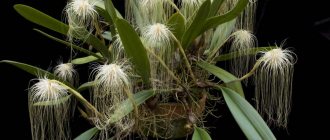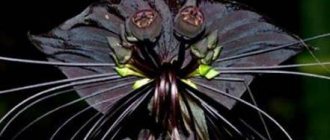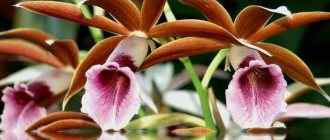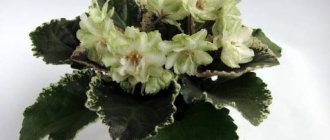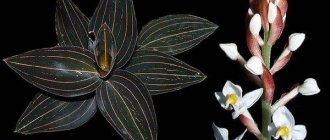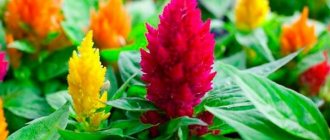Orchids are so beautiful and noble that they are purchased not only for the collections of amateur flower growers, but also for interior decoration .
In any case, when purposefully choosing a plant of a specific color, you need to be prepared for the fact that its intensity changes under the influence of different conditions .
Let's take a closer look at what a white orchid with purple spots looks like and in which varieties this color is found.
Description
Purple spots, specks, stains on pure white, lilac with a white or pinkish-white background are a very common color of orchid petals, as they are closest to natural . The white and purple orchid occurs in different species.
All features of the appearance of spotted exotics can be grouped as follows:
- Small round spots densely decorate the flower, scattering in rows of beads from its core to the edges of the petals;
- Purple markings are collected along the edges of the white petals and slightly touched the core;
- Purple blots are randomly scattered across the entire surface of the petals. The flower looks like it has been splattered with ink;
- Only the core of the flower is purple;
- The spots are large, but very pale, more like a shadow falling on a white petal.
The color intensity, density and size of the spots may vary .
Orchids that are completely violet or lilac in color are common, but blue is extremely rare; orchids of this color are quite expensive. Supermarkets sell plants that have turned blue using chemicals !
First of all, we need to mention the widespread Phalaenopsis, familiar to every orchid lover. There are several varieties of it, decorated with various purple spots and veins . Dendrobium, Vanda and Cattleya orchids also often present similar colors.
The core, painted in a soft purple color, gives the flower special expressiveness and sophistication. Similar fine examples can be found among Dendrobiums and Phalaenopsis.
The main problem that can disappoint a gardener is the change in color of the petals depending on the conditions of the plant. This happens:
- Increase or decrease in its intensity;
- Violation of the original drawing.
Distinctive characteristics of the species
Phalaenopsis mini (Phalaenopsis) grows a maximum of 20 cm in both height and width. It consists of branched peduncles on a straight stem with a large number of flowers, each shaped like a butterfly.
But the number of leaves is small - about 4-5 pieces. But this is enough for the flowers to be fully saturated with moisture and nutrients. Mini-orchids come in a variety of colors: from white to deep purple.
The root system of the plant is powerful, despite its miniature size. The processes are well developed, their surface is covered with multilayer tissue. In favorable conditions, flowering begins in the spring and lasts up to 6 months.
Features of care
When buying a plant in a store, you need to understand that it was grown in ideal conditions on an industrial farm. The light regime, adjustable humidity and frequency of watering, as well as the methodical application of special fertilizers ensure the full bright color required by the variety standard.
Placed in home rooms and office spaces, exotics experience a deficiency or excess of :
- Sveta;
- Heat;
- Humidity;
- Nutrients.
These orchids need to be cared for in the same way as regular ones.
A change in living conditions cannot but affect the green pet. The greatest influence on the state of coloring is influenced by illumination and the full supply of minerals. But not everything is so critical! Sometimes a new color can even please the owner with more delicate shades . Of course, the standard can almost always be restored with some effort and adjustments in care.
Important! The color of the orchid will constantly change depending on changes in living conditions.
Types of phalaenopsis with photos
Pleasant (amabilis, Amabilis)
Up to twenty delicate white flowers bloom simultaneously on the graceful curved branches of this plant.
Amabilis.
The center is pale yellow with a pattern of pink, red and brown specks.
The edges of the lower petals are narrow and often curved upward, like teeth. The subtle, barely noticeable aroma gives it a special charm.
Schilleriana
The leaves of a plant that grows in suitable conditions have a subtle silvery pattern on the outside, as if marbled.
Schilleriana.
A whole waterfall of petals can bloom simultaneously on one peduncle - 250 flowers is not the limit, but an average number!
Shades of Phalaenopsis Schiller can range from pale pink to sophisticated burgundy.
Stuart (Stuartiana)
A profusely blooming species of Phalaenopsis Stewart, it features an attractive pattern on white flowers.
Stewart's Phalaenopsis has red spots on the base and a specific pattern.
A raceme of several dozen flowers develops on a peduncle up to 60 cm long.
The long, up to 20 cm leaves of the plant also have a pattern of silver-gray rounded spots.
Has a weak aroma.
Sandera (Sanderiana)
It is rare and expensive. The flower brush is located on several branches.
Sanderiana.
The total height of the peduncle is slightly less than a meter, about 80 cm. Large flowers, up to 10 cm in diameter, are white or pink.
The leaves have a dark green complex pattern.
Pink (Rosea)
A petite beauty with an intricate veining pattern on the large upper petals and a contrasting lip in a darker shade of purple.
Rosea. Photo taken from flickr from a certain Carl Baldini.
The name of this species accurately describes the coloring features. The diameter of the flower is only about 3 cm, and the peduncle is no higher than 20 cm. The leaves are a rich dark green color.
Gigantea
Flowers 3-4 cm in diameter are collected in a luxurious inflorescence in the form of a cone, drooping down.
Very large Phalaenopsis gigantea.
The leaves of this giant are often longer than the peduncle - up to fifty cm, and the peduncle usually does not exceed forty.
The flowers are variegated in shades: purple, beige, terracotta. The green mass is also often decorated with a pattern of light gray speckles.
Horse (Equestris)
Small flowers of this species are only 2-3 cm in diameter, but this only adds lightness and grace.
Equestris.
This baby's flower brush is only 20 cm in height, but it looks voluminous and lush.
Many small branches form an airy flower cluster.
At its tip, new buds grow and bloom, thanks to which it blooms all year round with good care.
Staghorn (cornu-cervi)
In comparison with its lush, bright neighbors, this phalaenopsis looks extremely unusual.
The coloring resembles the horns of a young deer.
With its shape, the staghorn phalaenopsis resembles not only the horns of a young deer, but also a starfish.
The shape is noticeably different, the petals look thicker and stronger.
The plant is miniature, but produces several flower stalks with many branches at once.
The inflorescences are varied in color from yellow ocher to reddish brown.
Luddeman
The petals look like they were painted by an artist. This species is extremely varied in colors.
Phalaenopsis Luddeman.
There are yellow flowers with red stripes, white with purple. A plant in full bloom can bloom regardless of the time of year.
Although there are very few flowers on the peduncle, no more than 7, they are quite large and smell pleasant. Average diameter 6 cm.
Ambonian (amboinensis)
This species of the orchid family blooms all year round, opening buds one after another. As a rule, there are several flower stalks at once.
Ambonian phalaenopsis.
Striped petals with bright, attractive colors stand out among the pink and purple palette of popular varieties.
Parisha (Parishii)
Among all the variety of these beautiful plants, there is not a single one that could be called ordinary.
Parishii.
Parisha is one of the more exotic varieties, a tiny potted plant with aerial roots and leaves that looks like a painstaking composition created by a florist.
Hybrids based on it are used to create mini-phalaenopsis.
Hieroglyphic (hieroglyphica)
The complex painting on the individual petals of this large plant is not repeated even on one peduncle.
Hieroglyphic.
Leaves up to 30 cm, many flowers on several peduncles look like a living bouquet.
Leaves and flower stalks tend to droop, so a stand is needed. A plant full of detail and personality.
Bloom
The flowering of white-purple varieties of orchids is no fundamentally different from the flowering of orchids of other colors. The season and frequency depend on the type of exotic and its requirements for light, humidity, and temperature. The most unpretentious of all is Phalaenopsis.
A valuable feature of this exotic beauty is its long flowering . Opened buds can retain their fresh appearance for a month, or even longer. In addition, new flowers open to replace the fading calyxes on the peduncle.
With proper care, the orchid will bloom regularly. True, if a pot with a plant is placed on a south or south-east window, the color of the flowers, as well as the leaves, may become paler. Only Cattleya will enjoy the bright sun; all other varieties should be shaded .
Experienced gardeners can further stimulate the formation of new flower stalks by manipulating the watering and lighting regime. To artificially induce flowering , a period of dry maintenance is organized with a sharp, approximately half, reduction in watering.
After about a month or two, when flower stalks appear, they begin to apply fertilizer . First, they contain nitrogen, and when buds appear, they contain potassium. A lack of nutrients also does not allow the plant to fully display its full standard color.
Types of orchids, their names and photos
In this section you will learn what types of indoor flowers there are, their descriptions, pictures of plants of the orchid family.
With bulbs
The bulb, or more precisely the pseudobulb (tuber, tuberidium) is a storage of nutrients. The thickening at the bottom of the stem, the “outer bulb.”
Plants with pseudobulbs belong to the sympodial type of development.
What types of orchids with pseudobulbs are there:
- lelia;
- oncidium;
- miltonia;
- odontoglossum;
- Cattleya;
- dendrobium;
- carrot orchid.
You can read more about the Lelia orchid here.
Unpretentious
Indoor phalaenopsis hybrids grow and bloom well in living rooms and are well suited for beginning gardeners. Most other species and varieties require a more individual approach.
Dendrobium, Cattleya, oncidium, Vanda are also quite easy to grow, observing the conditions: during the day it is 7 degrees warmer than at night, do not overwater in winter.
Cattleya (photo of flowers in pots).
Sympodial
Sympodial species grow in bushes, with several shoots from one rhizome:
- Cattleya;
- Cambria;
- oncidium;
- Cymbidium.
The main root is located horizontally inside the soil; new shoots with pseudobulbs easily grow from it.
Orchids are divided into monopodial and sympodial types.
Smelling
The aroma of orchids varies from completely absent to a strong, pleasant fragrance. Vanilla type flower is also used in the food industry.
The most odorous types:
- vanilla;
- lelia;
- miltonia;
- celogina;
- Cattleya;
- dendrobiums;
- phalaenopsis (many varieties);
- cymbidiums;
- Cambria;
- zygopetalum;
- miltoniopsis;
- oncidium.
Rare
The orchid family is so vast and unusual; there is a considerable list of rare species. Here are the most beautiful and rarest of them:
Royal blue phalaenopsis. Botanists from the Japanese university Chiba University created the Royal Blue variety based on the phalaenopsis Aphrodite, placing the blue gene in it. So far this miracle is not available to ordinary amateur flower growers. The basis of the unique new species is also rare - the phalaenopsis Aphrodite orchid is very difficult to propagate by seeds, so it is not grown on an industrial scale;
Royal blue phalaenopsis.
- white heron orchid, habenaria or leopard radiata;
- Flying Duck Orchid (Caleana Major);
- Odontoglossum.
Indoor
Varieties of indoor orchids include many varieties, since with skillful care even the most exotic plant will feel good, but with an inexperienced and inattentive gardener, even a stable hybrid phalaenopsis can quickly die.
Types of indoor orchids:
- phalaenopsis and its varieties;
- dendrobium;
- Wanda;
- brassia;
- miltonia;
- lelia;
- zygopetalum;
- celogina;
- cymbidium;
- oncidium;
- odontoglossum and many other species.
Find out more about what indoor orchids are and a description of these plants in our article below.
New
Based on natural species, every year new orchid hybrids are created for indoor cultivation with an extended flowering period and a reduced dormant period, of all kinds of shapes and colors.
New varieties are grouped according to the place of creation; for example, Taiwanese hybrids are distinguished.
By mixing the characteristics of different species, we obtained novelty phalaenopsis, on which new buds grow from the apical bud right during flowering. You can see a picture of the novelty variety below.
A variety of Phalaenopsis novelty flower.
Reviews
White orchids with a purple pattern look especially original, which is why they are popular among orchidists and ordinary gardeners.
Anna. “I always look forward to the Dendrobiums blooming. Every time you get a surprise: the pattern on the petals changes! Sometimes it is lighter, sometimes brighter. I used to be surprised and even worried about this, but now I just enjoy the beauty that comes out in any case!”
This type of orchid is very popular among amateur gardeners.
Vladimir. “Last year I bought a white Phalaenopsis with purple spots. I've been eyeing him for a long time. The first flowering at home did not disappoint. Specks of a beautiful purple color. Perhaps later the plant will ask me a problem, but for now everything is according to the standard! Yes, in winter I illuminate the orchids with a lamp, since I have a north side.”
Larisa. “The white Phalaenopsis with a purple core is something magical. I was specifically looking for one like this. It looks very subtle and goes well with the color scheme of my room. Very low maintenance. I follow the most basic recommendations, and the orchid continues to bloom profusely twice a year.”
What colors are there?
At home
Not all types of orchids existing in the world will take root in the house. Hybrid species feel best in the vicinity of humans.
Orchids suitable for cultivation in an apartment without creating special greenhouse conditions are divided into two groups according to growth forms:
- Monopodial. They have only one growth point. They are characterized by apical flowering. Growth is predominantly stem. That is, the height of the orchid increases, but leaf shoots do not grow. The leaves of monopodial orchids are dense, they create a reserve of moisture, they are usually green, but they can also be variegated. Flowers can be any shade ranging from white to pink, as well as light green, orange, lilac, yellow, and in recent years, black and blue.
- Sympodal. This type of home orchid has several growth points and flowering along the entire stem. This species usually does not stretch upward, but horizontally, for example, like a loach or grapevines. The leaves are narrow and thin and die quickly. Flowers can be yellow, purple, pink, have shades intermediate between these three colors, or mixed with white, and also have double colors, spotted and gradient.
In nature
The diversity of orchids in nature includes species that live underground (saprophytes), on trees (epiphytes) and in the soil, the latter usually having a bulbous root and capable of growing in temperate latitudes.
These plants can have any natural color, but they are not found in the wild:
- Blue and light blue orchids.
- Absolutely purple, flowers with this color have yellow, white or orange inclusions.
- Black, there is controversy about this, since there is a legendary version of the appearance of black orchids, according to which it was stolen by a botanist researcher from the mysterious tribes of South America who worshiped it. The legend has no evidence. There are also some endemic species whose color is considered black.
Artificially bred plants
In terms of breeding orchids, breeders act more intuitively than clearly and thoughtfully. But even those types of colors that were obtained by trial and error evoke enthusiastic exclamations.
Among them are orchids:
- blue;
- purple;
- spotted harlequin color;
- "tiger" color;
- pure white, without a single tint or inclusions;
- mother-of-pearl.
More than half of the current “running” colors of orchids are bred, which in no way detracts from their beauty.
